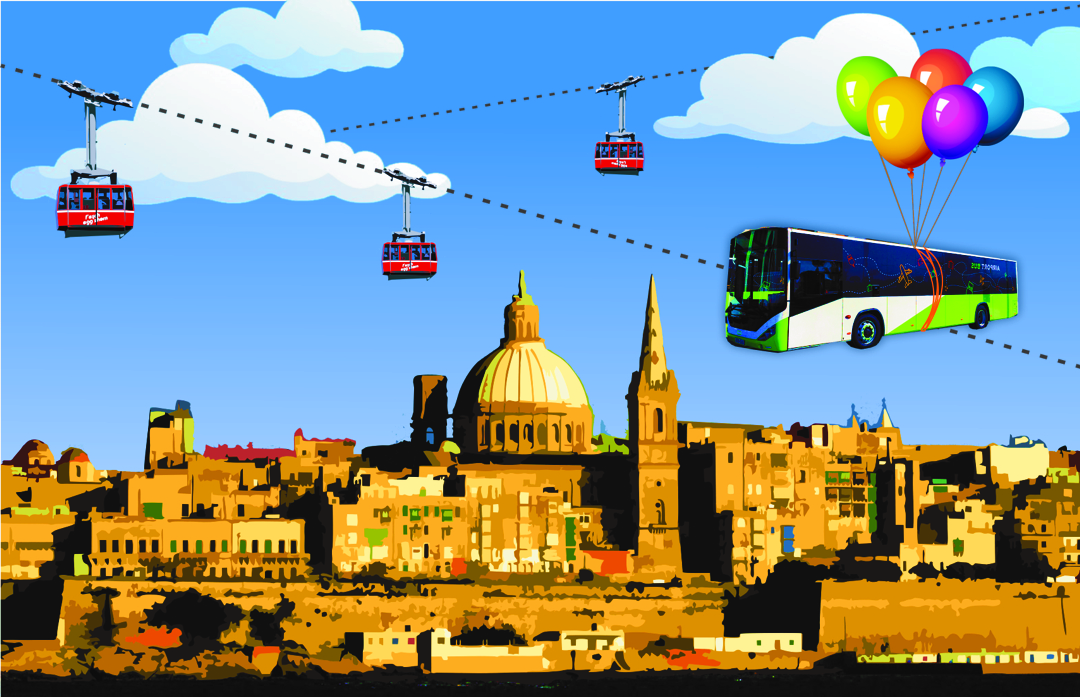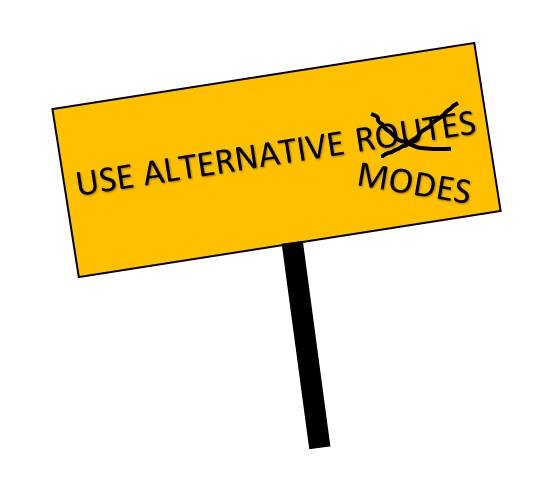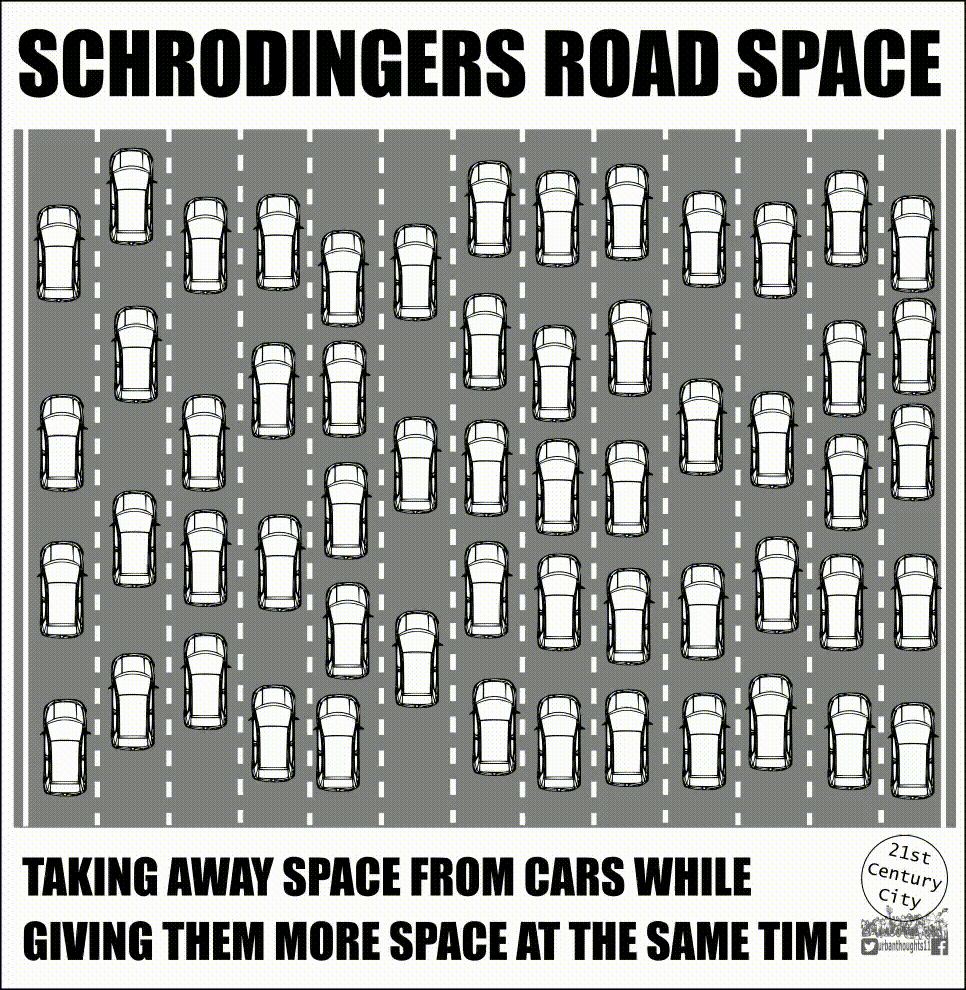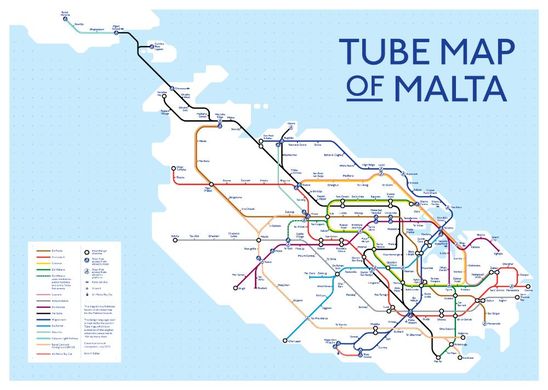
We all need access to education, work, healthcare, goods and services. We should therefore look at designing a transport system that provides equitable, affordable and efficient mobility options—truly a public transport.
by Suzanne Maas
Collage: Isles of the Left
This article is also available in audio as part of the Isles Aloud Podcast.
![]()
[dropcap]I[/dropcap]f you’ve spent some time on the road in the past few months (and well, who hasn’t?), bright orange signs cheekily advising to ‘seek alternative routes’ couldn’t have escaped you. These alternative routes are meant as a solution to avoiding the many road closures, blockages, and general havoc caused by a massive road widening exercise brought about by the government in a feeble attempt to solve disastrous gridlock on our islands’ roads.
This gridlock takes a toll on our health. More often than not, the air pollution in the areas around the harbours is palpable. According to the European Environmental Agency’s latest report on air quality, the emissions of particulate matter, nitrogen oxides and ozone have increased in Malta in the past few years, largely due to road transport, and that contributes to premature deaths as a result of heart and lung disease. The Environment and Resources Authority (ERA) recently published the State of the Environment report which confirms that students in classrooms facing roads suffer from a higher rate of respiratory conditions. The irony is that children are being taken to school by car because it would be too dangerous to walk, scoot or cycle.

Why Do We Need to Move Away from Car Dependence?
Promoting only one mode of transport, and improving infrastructure solely for the car, deepens our car dependence and excludes everyone else outside the car. It is becoming increasingly difficult to live without a car, with road space being taken away from more sustainable modes (through the removal of dedicated bus, cycle lanes and even pavements). The growing network of busy roads makes crossing them a challenge and severs communities. A car-dependent society effectively excludes those who cannot afford a car, or cannot drive one due to age, disability, choice or affordability. Thus, a fair and equitable transport system should serve everyone, not just those in a position to own and drive a car.
[beautifulquote align=”left” cite=””]Because of omnipresent and haphazard parking, soft modes of transport, such as walking and cycling, become increasingly difficult and unpleasant.[/beautifulquote]
In a country where space is at a premium, how can we accept the occupation of so much public space by private property? As Donald Shoup, professor in urban planning, states in his book ‘The High Cost of Free Parking’, cars are parked over 95% of the time. Because of omnipresent and haphazard parking, soft modes of transport, such as walking and cycling, become increasingly difficult and unpleasant.

Millions upon millions of euros are being spent on widening the roads: €17 million for additional road space in Marsa, Żebbuġ and Luqa, among others. Add to that €7 million for the upgrading and widening of Regional Road, and a projected €55 million for the Central Link project. The list goes on.
[beautifulquote align=”left” cite=””]With the number of cars on the roads steadily increasing at the rate of 33 vehicles per day, they will soon fill up the additional created space and get stuck in further bottlenecks.[/beautifulquote]
The Ministry for Transport and Infrastructure, and the newly established agency Infrastructure Malta, are proudly throwing these numbers around as if they were confetti. All the while, we know that this strategy will not be effective in the long run: with the number of cars on the roads steadily increasing at the rate of 33 vehicles per day, they will soon fill up the additional created space and get stuck in further bottlenecks. This concern was also raised by the Ombudsman’s Environment Commissioner a few weeks ago in his reaction to the publication of the latest State of the Environment Report.
Before the public even gets a chance to discuss whether these projects would truly improve our quality of life, the fresh tarmac is already laid.
The road works at Tal-Balal are taking place without a PA permit, let alone a public consultation process. Strategic planning documents—the Malta Transport Plan 2025, the Malta Transport Strategy 2050, and the Strategic Plan for Environment and Development (SPED)—that are supposed to guide infrastructural projects of this scale, are blatantly ignored. In addition, we are paying a (comparatively meagre, but not insignificant) near €200,000 a year for not meeting our emission reduction targets. At the same time, the government announced that phasing out of diesel and petrol cars in order to meet greenhouse gas emission reductions, as per the Paris climate agreement, is in the pipeline, with a study on different scenarios underway. This begs a question: why therefore spend all those public funds on further fuelling our car dependence?
While many of us often think of Malta as a special place, with respect to transport it isn’t special. Every Western city, even those now renowned for their public transport systems and pedestrian and cycling infrastructures, once grappled with the same issues: streets clogged with cars, illegal parking on sidewalks and air pollution… Sounds familiar, right?
While the context behind the models adopted by Copenhagen and Amsterdam may be different to that of Malta, there are also admirable examples closer to home.
[beautifulquote align=”left” cite=””]The Spanish town Pontevedra successfully removed most of the cars from the city centre, turning it into a pedestrian haven with cleaner air.[/beautifulquote]
In Seville, for example, the number of trips by cyclists grew five-fold in 3 years, following the introduction of a bicycle sharing system and the creation of dedicated cycling infrastructure. In an effort to reduce pollution and emissions from cars, Bologna opted for the innovative approach which rewards citizens for choosing green travel modes—walking, cycling or using public transport—with free beer, ice-cream or cinema tickets. The Spanish town Pontevedra successfully removed most of the cars from the city centre, turning it into a pedestrian haven with cleaner air, reduced emissions, and a thriving hub for small, local businesses.

Examples from these cities show that investing in public and active transport can achieve three goals simultaneously: first, it can move more people more efficiently; second—free the road space for more socially and environmentally beneficial modes of transport; and third, it can lower local health and environment concerns.
Suggestions: Transport for Everyone
Why not use public funds to invest in an alternative transport future? Rather than short-term non-solutions like road widening measures, we need to imagine an alternative pathway; a route to sustainable mobility that will serve everyone. There are plenty of potential solutions out there.
[beautifulquote align=”left” cite=””]Bus Rapid Transit (BRT) systems: the backbone of public transport, the bus, has been reinvented in recent years.[/beautifulquote]
In many countries, the backbone of public transport, the bus, has been reinvented in recent years. Bus Rapid Transit (BRT) systems, which have been popularised in North and South America, are high capacity, fast and frequent bus services that operate using dedicated bus lanes and boarding platforms, off-board fare collection, smartcard payments, and sleek design and marketing campaigns. The most famous BRT system is probably the TransMilenio in Bogotá, Colombia, which transports tens of thousands of passengers per hour in each direction on its busiest corridor. Together with the investment in a city-wide cycling network, Bogotá’s BRT is hailed as a shining example of how integrated transport solutions can transform the urban environment and make the bus appeal to the masses again.
The creation of a light rail or metro system has sparked the imagination of many. A London style Tube Map of Malta by Jonathan Galea, on display during the Malta Design Week 2014, was in the author’s words “in no way a proposal, but rather a social commentary and piece of graphic art”. However, a few years later the discussion about a mass transit system for the Maltese Islands has taken on a more serious tone, and has been put forward as a potential long-term solution by different political and business figures on the islands, from influential entrepreneurs and architects to the former opposition party leader.

Overground and underground are not the only options available when it comes to public transport for the Maltese islands.
The harbour ferries linking Valletta to Sliema and the Three Cities have been re-introduced with success in the past years. There are plans to extend the ferry services to other localities on the Eastern coast of the island: from the Harbour area to the north (St. Julian’s, Buġibba, and all the way up to Gozo) and southwards towards Smart City and Marsaskala.
[beautifulquote align=”left” cite=””]A proposal putting forward the idea for an urban cable car network for Malta deserves due consideration.[/beautifulquote]
Even the sky need not be a limit. A proposal putting forward the idea for an urban cable car network for Malta deserves due consideration. Such a model could provide an efficient public transport service at 10-30% of the cost of a metro system, while not putting further pressure on scarce land. Cable car services have been introduced in other European cities such as Porto and Dubrovnik.
Going up in the air is also the premise of the proposal for “the (real) alternative grid”, a solution put forward by a local architectural firm to create a separate network of pedestrian and cycling paths, levelling off elevation differences between towns by crossing valleys on raised flyovers, as well as through the use of existing and new tunnels.
Independent, smaller initiatives can also make a difference. Earlier this year, the Żejtun primary school in collaboration with the local council, organised a bike-to-school day, and the Safi local council has just been awarded funding to start operating a ‘walking bus’ to school, in which kids are picked up along a route and under the guidance of adults, can walk to school safely. For walking and cycling to become daily accepted modes of transport again, safe, direct and attractive infrastructure is needed, as well as a legal framework that defends these most vulnerable road users.
[beautifulquote align=”left” cite=””]For walking and cycling to become daily accepted modes of transport again, safe, direct and attractive infrastructure is needed, as well as a legal framework that defends these most vulnerable road users.[/beautifulquote]
Shared mobility solutions, such as bicycle, scooter and car-sharing, as well as ride-sharing (carpooling) and ride-hailing services have also been introduced in recent years, and add further mobility options to a modern, multi-modal transport landscape. Perhaps less innovative, but nonetheless effective, are organised forms of shared transport, such as scheduled minivans and buses for schoolchildren and workers in employment hubs.
Mobility as a Basic Human Right
While a mass-transit network can deliver on some strategic axes where demand is high, experiences from across Europe show that in many cases, there has been too strong a focus on expensive mass-transit projects with limited scope, serving only a sub-section of the population, while ignoring the mobility needs of those living outside of the mass-transit corridor. In addition, the required large capital investments have often meant a transfer of public to private ownership, in an attempt to let ‘the market’ dictate the appropriate price for an efficient service, and ameliorate the losses experienced by public transport services across Europe in the past decades. These developments have eroded the level of service of public transport, and its initial promise to provide transport for all.
Mobility is a basic human need. We all need access to education, work, healthcare, goods and services. We should therefore look at designing a transport system that provides equitable, affordable and efficient mobility options—truly a public transport.
No single silver bullet solution will magically solve the transport conundrum we have on our hands. We need to look at this problem from a long-term and holistic perspective.
[beautifulquote align=”left” cite=””]What is needed is the full integration of transportation modes, not only physically, but also financially, so that they can become desirable alternatives and can be used in a multi-modal mix.[/beautifulquote]
Large scale mass-transit options may have a place in our future transport system, but, while studying the feasibility of those potential models, we should focus in the short term on picking the low-hanging fruits and make use of the assets we already own: improve the reliability, speed and frequency of bus services through the creation of dedicated lanes, fast boarding platforms, and integrated payment solutions, extend the ferry network and introduce further fast ferry links; and prioritise pedestrian movement within village cores and town centres, and safe cycling routes between localities.
While the transport landscape on the Maltese islands is modernising and diversifying, what is needed is the full integration of these modes, not only physically, but also financially, so that they can become desirable alternatives and can be used in a multi-modal mix. This is the premise of the newest buzzwords in the transport sector: Mobility-as-a-Service (MaaS), a subscription approach to mobility which builds on seamless integration of transport networks, real-time mobility information and integrated payment options. Important however is to ensure that Mobility-as-a-Service is designed and executed not just to provide the hypermobile younger middle- and upper-classes with even more mobility, but that such a model actually caters for all members of society. In other words, it must offer an affordable transport service for everyone.
Ultimately, for any combination of transport modes to become a true alternative to the privately owned car, it has to offer a real alternative in terms of costs, comfort and convenience. The required modal shift to alternative modes of transport will not happen only by providing ‘carrots’, but will require ‘sticks’ to curb the excessive freedoms and claims on public space of private cars, too.

Suzanne Maas is currently conducting doctoral research on cycling with the Institute for Climate Change and Sustainable Development at the University of Malta, and is a board member of Friends of the Earth Malta.

Leave a Reply